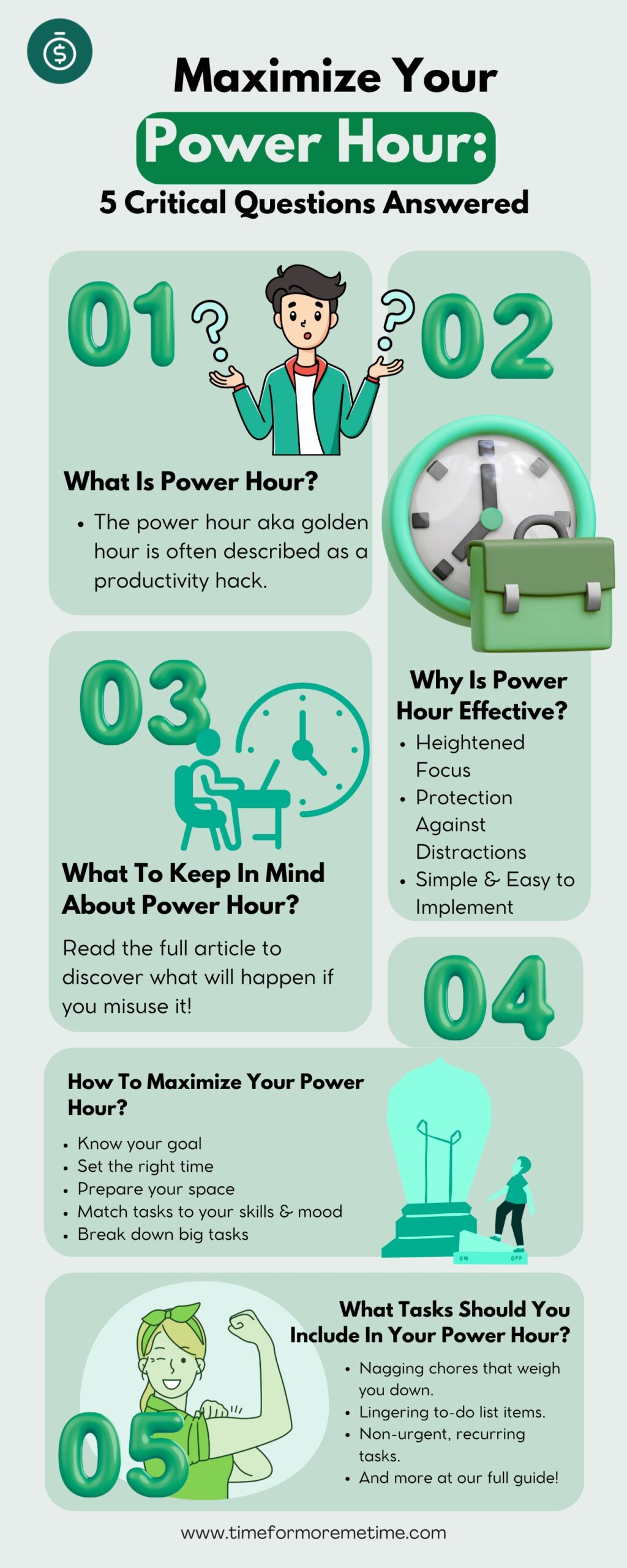
My morning routine is critical to me. Without it, I’d feel scattered, forget important tasks, and waste valuable time trying to catch up. It’s not just about ticking boxes—it’s about letting me set the tone for the rest of my day and save time. Having this routine is basically one of my most effective time management strategies.
Like me, some of you might already have a morning routine in place. But maybe it’s not working as well as you’d hoped. Why might that be? I believe the problem could be that you’re not fully utilizing your power hours.
Power hour, what’s that? Well, let me tell you a quick story.
A month ago, I reflected on something: why are morning routines so effective? I can easily stick to the tasks I set for myself in the morning, but when it comes to my evening routine, it’s a completely different story.
What’s even more interesting is how much my productivity drops when my schedule or sleep shifts later. On days when I wake up later than usual, I can’t seem to achieve the same focus and efficiency I do on a regular day. At first, I thought it was because I felt groggy or tired after sleeping in. But the more I thought about it, the less sense that explanation made.
Then it hit me—there’s something unique about mornings. Our bodies follow the natural rhythm of the day—the circadian rhythm—and mornings are when everything seems to align perfectly. That’s when I remembered reading about the concept of power hour.
1. What Is Power Hour
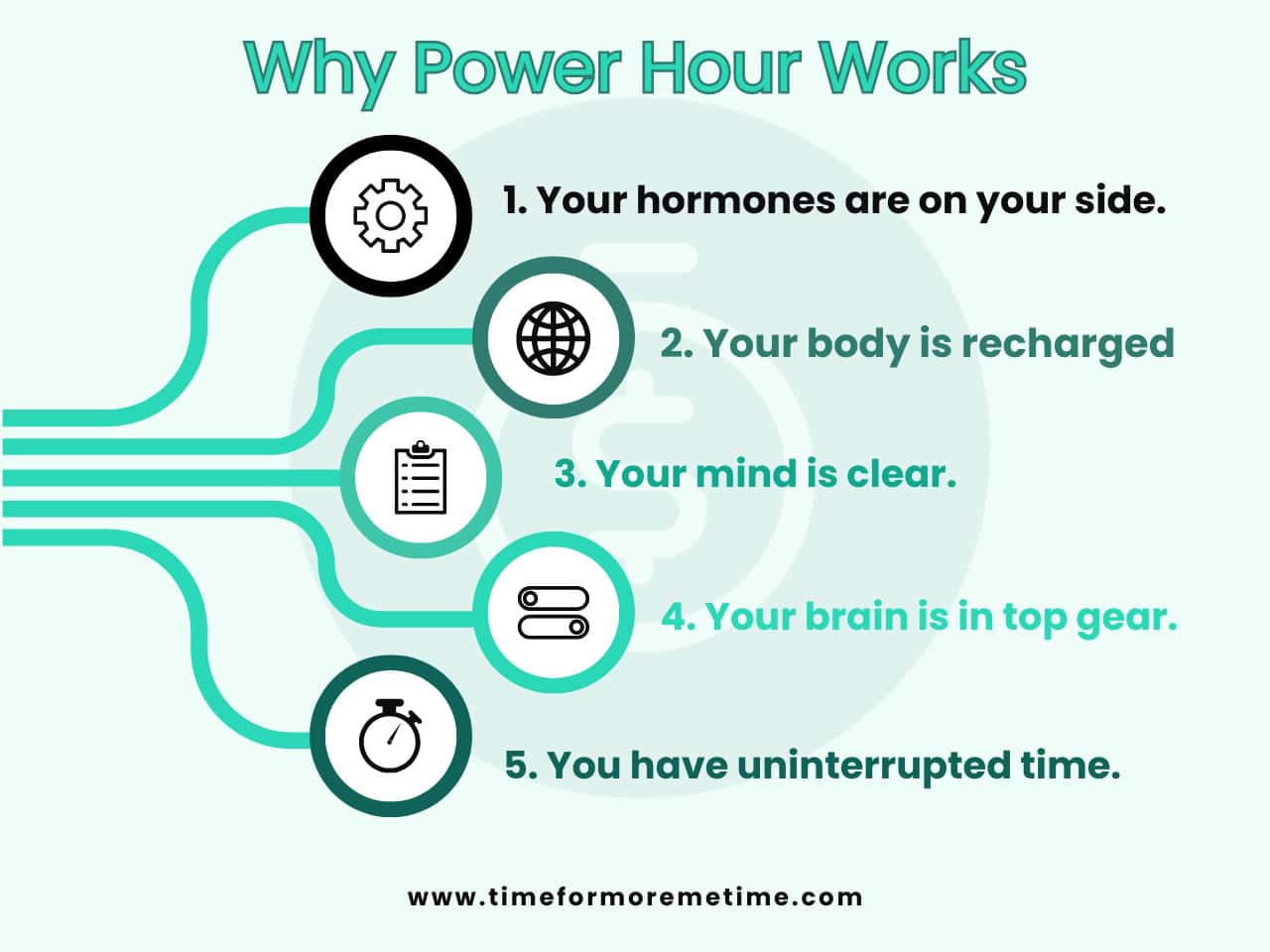
The power hour—also called the golden hour—is often described as a productivity hack. By the way, power and golden hour are terms that have a lot of meaning. In this post, we’re going to talk about the power hour that refers to the first 60 minutes of your day when your mind and body are at their best.
Your power hour is the time to focus on your most important tasks, and for many people, it’s when they’re able to tackle their morning routine with ease. That’s how I remember it.
Moving on, the power hour is essentially a time-blocking technique that takes advantage of your body’s natural state in the morning and other critical variables. Here’s why it works:
- Your hormones are on your side. In the morning, your body’s cortisol levels are naturally higher, boosting energy, focus, and alertness. This is caused by the cortisol awakening response (CAR), a part of the body’s stress response system.
- Your body is recharged. After a good night’s sleep, you wake up refreshed, ready to tackle challenges with renewed vigor.
- Your mind is clear. Having just woken up, you’re free from the mental clutter or boredom that can lead to distractions later in the day—basically an effective distraction reduction.
- Your brain is in top gear. The brain’s prefrontal cortex—the part of the brain responsible for decision-making and creativity—is highly active in the morning, explaining those brilliant “shower thoughts.”
- You have uninterrupted time. Mornings often offer a window of freedom before work, school, or family responsibilities demand your attention.
Even our ancestors relied on this natural rhythm, using the early hours for essential survival activities like hunting or gathering. The power hour is a modern twist on that timeless instinct—a chance to harness the best of your mornings for personal growth and productivity. And we should take advantage of it!
2. Why Is Power Hour Effective?
The power hour is pretty amazing, isn’t it? Just understanding why it works is enough to convince anyone to make the most of it. Personally, I swear by it!
But what happens when you take control of your power hour and use it to your advantage? Based on my experience, here’s why it’s so effective:
- Heightened Focus: During the power hour, I find myself deeply focused, which carries over into the rest of my day. This undivided attention creates momentum, especially when I start by tackling meaningful tasks.
- Protection Against Distractions: The morning power hour is like a shield from distractions. Most people are still asleep, and there’s little to interrupt your flow. This quiet, uninterrupted time allows you to work in peace, making it incredibly productive.
- Simple and Easy to Implement: The best part about the power hour is how simple it is! You might not even realize you’re doing it. All it takes is dedicating the first hour of your day to meaningful tasks, and the benefits naturally follow.
That said, while the power hour is an easy and effective way to boost productivity, it’s possible to overdo it. What happens when you push it too far? I’ll dive into that in the next section.
3. What To Keep In Mind About Power Hour?
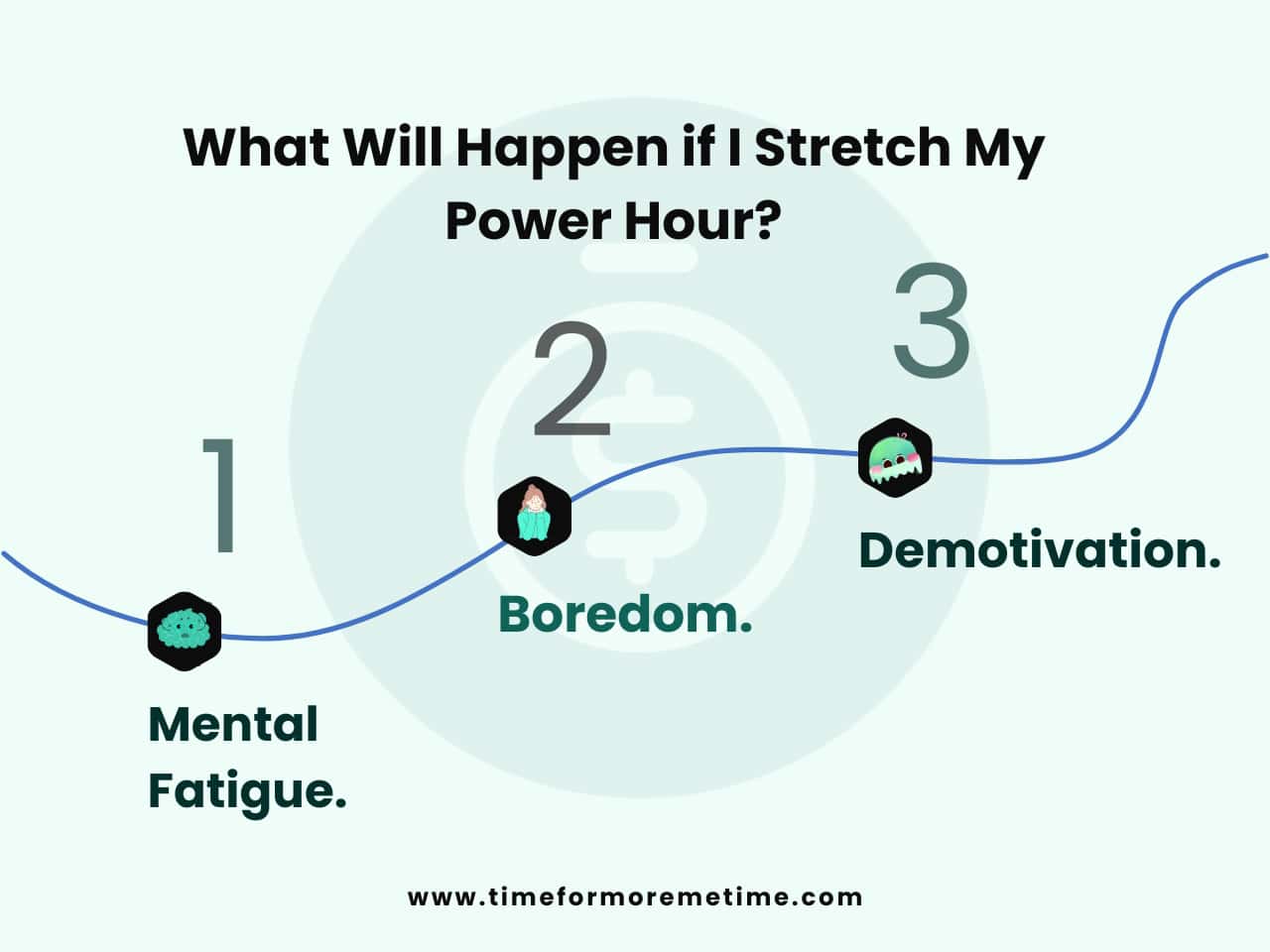
While embracing your power hour can be a game-changing productivity move, it’s also easy to misuse—and trust me, I’ve been there. When I rediscovered the power hour a month ago, I was thrilled. I dove into social media and scoured Google, eager to learn everything I could to maximize its potential and reclaim more time for myself.
I experimented, pushed the limits, and tried to stretch my power hour beyond its natural boundaries. The result? I failed miserably. Here’s what I learned from my mistakes:
- Mental fatigue. When I tried to extend my power hour into a second hour, I hit a wall. Instead of being productive, I felt mentally drained. Our brains have limited focus and aren’t designed for long stretches of intense focus without breaks. Overworking during the power hour can lead to burnout, making it harder to stay consistent. Lesson learned: stick to one hour and take a break before moving on.
- Boredom. Overloading my power hour with too many tasks or unrealistic goals backfired. Instead of feeling productive, I felt bored and disconnected. The power hour isn’t a magic solution to cram everything into your morning—it works best when balanced with your energy and realistic limits. Lesson learned: focus on quality, not quantity.
- Demotivation. At one point, I decided to tackle my most difficult task during the power hour every single day. Big mistake. This approach quickly became overwhelming. Instead of feeling accomplished, I felt defeated and demotivated, which completely defeated the purpose of the power hour. Lesson learned: start with tasks that inspire progress, not pressure.
These missteps taught me the importance of balance. They set me back, and it took me at least two weeks to recover and get back on track. To help you avoid making the same mistakes, I’ll walk you through how to start your own power hour step by step in the next section—and show you how to make it truly work for you.
4. How To Maximize Your Power Hour?
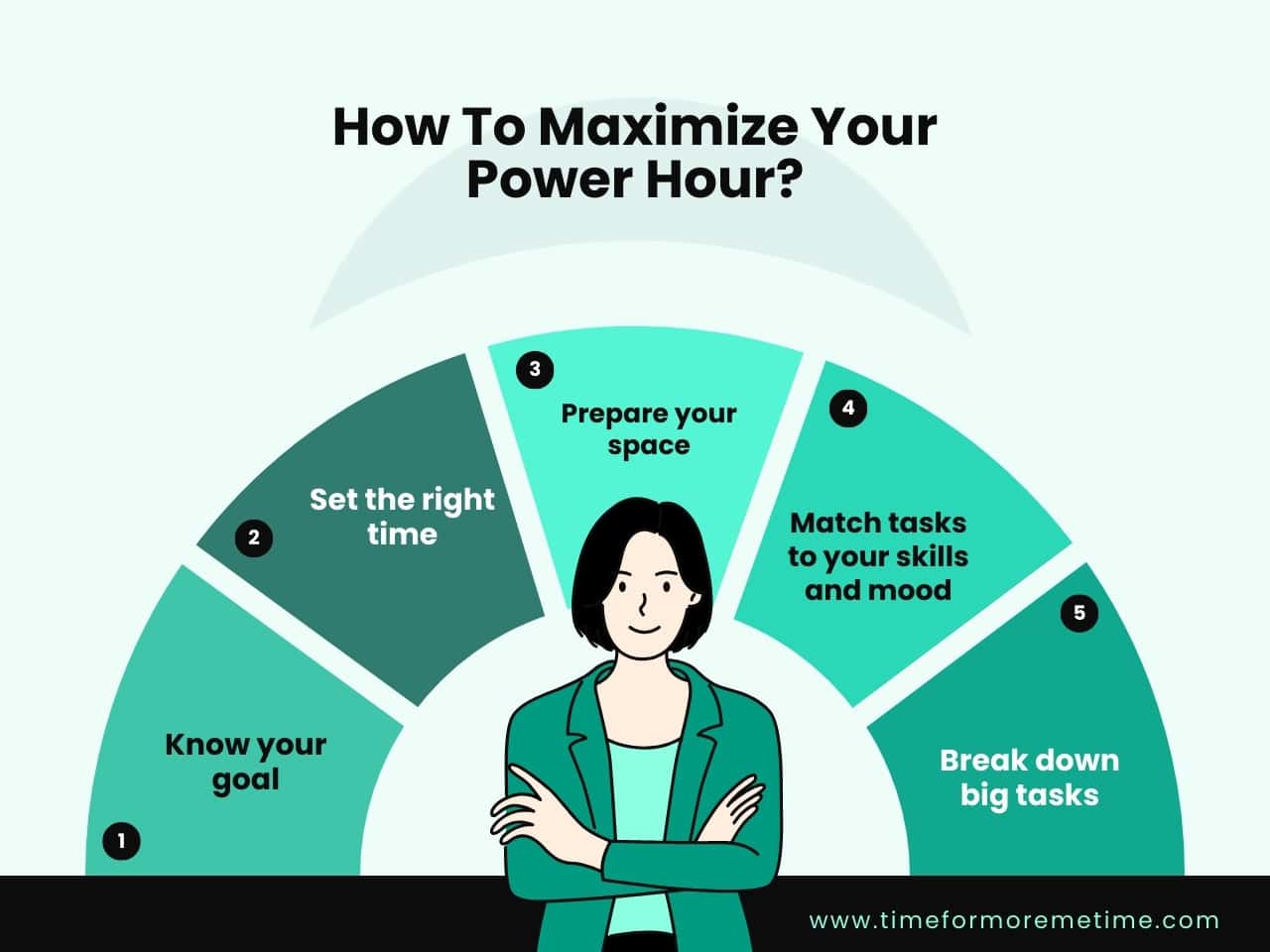
After learning what not to do during a power hour, I discovered what works to make it a natural and efficient part of my morning routine. If you’re ready to maximize your productivity, here are the steps to create an effective and manageable power hour:
- Know your goal. What do you want to achieve during your power hour? Is it about sticking to your morning routine, finishing homework, or tackling tough work tasks? Maybe it’s focused on health, school, or just carving out more personal time. Be specific about your goals so you can approach them with clarity.
- Set the right time. For most of us, energy peaks right after waking up, making mornings ideal for a power hour. But some people have different energy rhythms. Identify your own peak time, whether it’s morning, afternoon, or evening, and schedule your power hour accordingly.
- Prepare your space. If your power hour starts as soon as you wake up, set up your environment the night before. Ensure your bedroom (or workspace) is distraction-free and supports focused effort. A clean, organized space can make a big difference in your ability to concentrate.
- Match tasks to your skills and mood. Don’t dive into the hardest tasks first unless you’re ready for the challenge. Choose activities that match your current skill level and motivation. The goal is to enter a flow state, where you’re fully immersed and productive without feeling overwhelmed.
- Break down big tasks. Sometimes, you can’t avoid dealing with tasks that feel overwhelming. When this happens, break them into smaller, manageable steps. Focus on completing just one part during your power hour and leave the rest for later in the day—or your next power hour. You can also employ delegation strategies if you’re mostly doing work in the morning to further break down the tasks.
By following these steps, you’ll not only create a productive power hour but also make it an effortless and rewarding part of your routine. Ready to give it a try? You’ll be surprised at how much you can achieve in just 60 focused minutes!
Of course, we can still further refine your power hour to make the most out of it. So, I’ll tell you the tasks I often do and recommend in my power hour, and you might find that they’re the same ones you need to do as well.
5. What Tasks Should You Include In Your Power Hour?
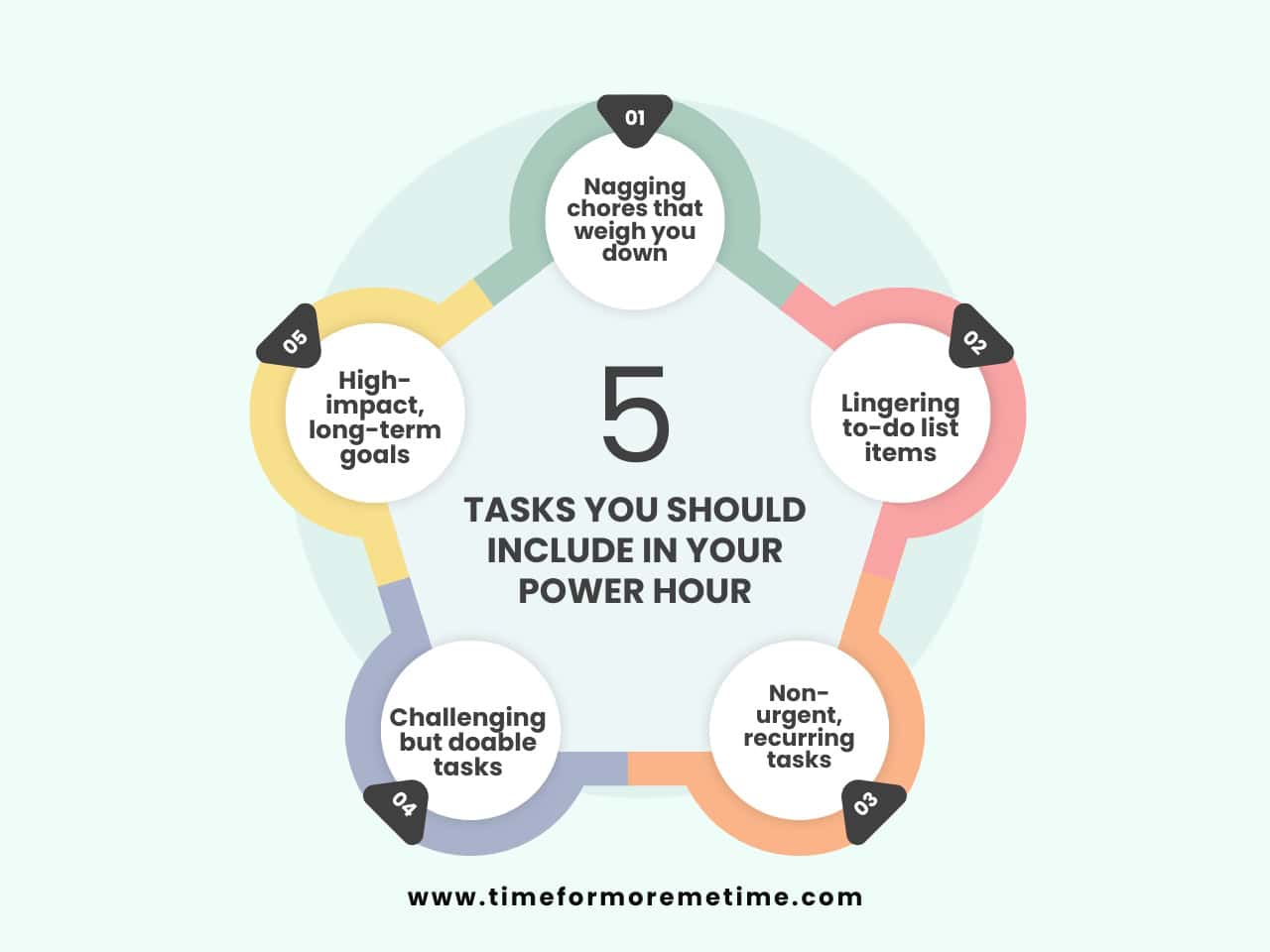
Not all tasks are created equal, especially when it comes to maximizing your power hour. Personally, I reorganized my morning routine to prioritize tasks that fit best within this focused time and saved others for the next hour after a short break.
To decide what to include, I used the Eisenhower Decision Matrix. It’s a simple tool for categorizing tasks by importance and urgency, helping you focus on what truly matters. You can easily download or create your own version of this matrix—it’s essentially a table where you organize tasks into four quadrants.
So, what types of tasks belong in your power hour? Here’s a breakdown:
- Nagging chores that weigh you down. We all have small, lingering tasks—like clearing your desk, sorting your inbox, or fixing that squeaky door—that sit in the back of your mind and drain your focus. They might seem insignificant, but completing them during your power hour clears mental clutter and frees up energy for bigger tasks.
- Lingering to-do list items. These are tasks that keep getting pushed from one day to the next. They’re not urgent but still important enough to finish. Your power hour is perfect for tackling these head-on and finally checking them off your list, breaking the cycle of procrastination.
- Non-urgent, recurring tasks. Think of tasks like paying bills, updating spreadsheets, or scheduling appointments—things without immediate deadlines but that need to be done regularly. Handling them during your power hour ensures they don’t pile up and disrupt your workflow later.
- Challenging but doable tasks. Use your power hour to tackle tasks that stretch your abilities without overwhelming you. This might mean brainstorming ideas for a project, solving a tricky problem, or learning a new skill. With your energy and focus at their peak, you’re in the best state to make progress on tasks that require critical thinking or creativity. If they seem too daunting, break them into smaller, manageable steps.
- High-impact, long-term goals. Your power hour is also the ideal time to work on meaningful goals that aren’t urgent but have a significant impact. This could be writing a chapter of a book, developing a business idea, or practicing a passion project. Dedicating this time to your big-picture ambitions ensures consistent progress and aligns your daily efforts with your long-term vision.
By organizing your tasks thoughtfully with tools like the Eisenhower Matrix and focusing on these categories, you’ll make your power hour a time of maximum productivity and meaningful progress.
FAQs
Before we wrap up this post, here’s a frequently asked questions section that might offer some additional insights:
1. Can the power hour work for people who aren’t morning-focused?
Yes, the power hour can be adapted to fit anyone’s natural energy rhythms. While mornings are ideal for many, some people experience their peak energy in the afternoon or evening. The key is identifying when you’re most focused and dedicating an uninterrupted hour to tasks that require your best mental effort during that time.
2. What’s the biggest mistake people make when doing their power hour?
The biggest mistake is overloading your power hour with too many tasks. Remember, the power hour isn’t a magic trick that will transform you into a productivity superhero. Piling on too much can lead to mental fatigue, boredom, and even demotivation. To avoid this, focus on meaningful yet manageable tasks and keep the hour productive without overwhelming yourself.
3. What should I do if I miss my power hour one day?
Don’t stress! Missing your power hour isn’t the end of the world. Productivity is about consistency, not perfection. If you miss it, try to carve out a focused hour later in the day or simply get back on track the next morning. The key is maintaining the habit over time.
Conclusion
In a world overflowing with distractions and the constant rush of daily demands, maximizing your power hour isn’t just another productivity hack—it’s a game-changer! Trust me on this.
By harnessing the power hour, I’ve managed to save time and energy, setting the tone for a productive day. It’s my launchpad for tackling work and all the chaos that comes with it.
I believe that you can make the most of your power hour, too. Just follow the tips I’ve shared and steer clear of the mistakes I’ve made—you’ll thank yourself for the change.
And if you stumble along the way, remember: it’s not only about crossing tasks off your list. It’s about building momentum, forming habits, and proving to yourself that you can focus on what truly matters. You’ve got this—good luck!
Oh, by the way, let me ask you this: Are you ready to take your productivity and financial goals to the next level? Explore more articles packed with tips on time-saving and money management, and don’t forget to subscribe to our YouTube channel for actionable advice and inspiration. See you there!







